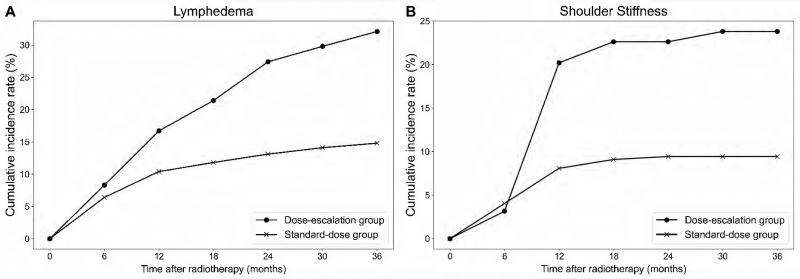글로벌 연구동향
방사선종양학
- 2025년 01월호
[Int J Radiat Oncol Biol Phys .] Toxicity Evaluation of Dose-Escalation in Hypofractionated Regional Nodal Irradiation for Breast Cancer: A Retrospective Study국립암센터 / 김의담, 유지성*, 김연주*
- 출처
- Int J Radiat Oncol Biol Phys .
- 등재일
- 2024 Nov 1
- 저널이슈번호
- 120(3):823-834. doi: 10.1016/j.ijrobp.2024.04.014.
- 내용
Abstract
Purpose: Regional nodal irradiation (RNI) to the axilla and supraclavicular area presents distinct toxicities, such as lymphedema and shoulder stiffness, compared with whole-breast irradiation. There is insufficient evidence on the safety of dose-escalation in hypofractionated RNI. We aimed to evaluate and compare toxicity rates in patients with breast cancer who received hypofractionated RNI with and without dose-escalation.Methods and materials: We retrospectively analyzed 381 patients with breast cancer treated with hypofractionated RNI between March 2015 and February 2017. Patients received either the standard-dose to the regional nodal area (43.2 Gy/16 fx; 48.7 Gy3.5 equivalent dose [EQD2], 2 Gy equivalent dose with α/β= 3.5 Gy) or dose-escalation with a median dose of 54.8 Gy3.5 EQD2 (range, 51.7-60.9 Gy3.5 EQD2), depending on clinical and pathologic nodal stage. Toxicity rates of lymphedema and shoulder stiffness were assessed, and statistical analyses were conducted to identify associated factors.
Results: The median follow-up time was 32.3 months (5.7-47.0 months). After radiation therapy, 71 (18.6%) patients developed lymphedema, and 48 (12.6%) developed shoulder stiffness. Patients who received dose-escalation exhibited significantly higher rates of lymphedema (32.1% vs 14.8%; odds ratio, 2.72, P = .0004) and shoulder stiffness (23.8% vs 9.4%; odds ratio, 2.01, P = .0205) compared with the standard-dose group. Moreover, dose-escalation showed a tendency to increase the severity of lymphedema and shoulder stiffness.
Conclusions: Patients who received dose-escalation in hypofractionated RNI face a higher risk of developing lymphedema and shoulder stiffness compared with those who received standard-dose hypofractionated RNI. Therefore, it is crucial to implement close and frequent monitoring for early detection, along with timely rehabilitation interventions for these patients.

Affiliations
Euidam Kim 1, Ji Sung Yoo 2, Yeon-Joo Kim 3, Jungnam Joo 4, Eun Sang Oh 5, Yoonsun Chung 1, Seung Hyun Chung 6, Tae Hyun Kim 5
1Department of Nuclear Engineering, Hanyang University, Seoul, Republic of Korea.
2Department of Rehabilitation Medicine, Research Institute and Hospital, National Cancer Center, Goyang, Republic of Korea. Electronic address: jsyoo@ncc.re.kr.
3Department of Radiation Oncology, Research Institute and Hospital, National Cancer Center, Goyang, Republic of Korea. Electronic address: yjkim1785@ncc.re.kr.
4Office of Biostatistics Research, National Heart, Lung and Blood Institute, National Institutes of Health, Bethesda, Maryland.
5Department of Radiation Oncology, Research Institute and Hospital, National Cancer Center, Goyang, Republic of Korea.
6Department of Rehabilitation Medicine, Research Institute and Hospital, National Cancer Center, Goyang, Republic of Korea.
- 연구소개
- 본 연구에서는 2015년부터 2017년까지 국립암센터에서 hypofractionated regional nodal irradiation을 받은 환자들의 부작용을 분석하였습니다. 기본선량만 받은 환자에 비해, 높은 선량을 받은 환자들에서 림프부종과 어깨관절 구축 발생 빈도 및 중증도가 높음을 확인하였습니다. 따라서, 림프절영역에 높은 선량을 받은 환자들은 부작용에 대해 면밀한 관찰이 필요하며, 부작용 발생 시 조기에 재활치료를 시작하는 것이 필요하겠습니다.
- 덧글달기
- 이전글 [Gynecol Oncol.] Mid-treatment MRI-based tumor response assessment for tumor recurrence and patient survival in locally advanced adenocarcinoma of the cervix: A retrospective multicenter study of KROG 23-03
- 다음글 [Int J Radiat Oncol Biol Phys .] Local Ablative Therapy Combined With Pembrolizumab in Patients With Synchronous Oligometastatic Non-Small Cell Lung Cancer: A Recursive Partitioning Analysis







